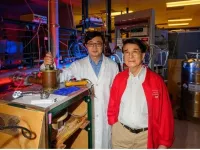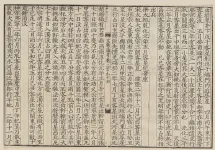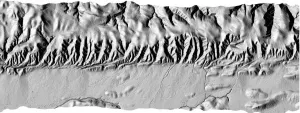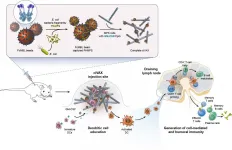(Press-News.org) In a critical next step toward room-temperature superconductivity at ambient pressure, Paul Chu, Founding Director and Chief Scientist at the Texas Center for Superconductivity at the University of Houston (TcSUH), Liangzi Deng, research assistant professor of physics at TcSUH, and their colleagues at TcSUH conceived and developed a pressure-quench (PQ) technique that retains the pressure-enhanced and/or -induced high transition temperature (Tc) phase even after the removal of the applied pressure that generates this phase.
Pengcheng Dai, professor of physics and astronomy at Rice University and his group, and Yanming Ma, Dean of the College of Physics at Jilin University, and his group contributed toward successfully demonstrating the possibility of the pressure-quench technique in a model high temperature superconductor, iron selenide (FeSe). The results were published in the journal Proceedings of the National Academy of Sciences USA.
"We derived the pressure-quench method from the formation of the man-made diamond by Francis Bundy from graphite in 1955 and other metastable compounds," said Chu. "Graphite turns into a diamond when subjected to high pressure at high temperatures. Subsequent rapid pressure quench, or removal of pressure, leaves the diamond phase intact without pressure."
Chu and his team applied this same concept to a superconducting material with promising results.
"Iron selenide is considered a simple high-temperature superconductor with a transition temperature (Tc) for transitioning to a superconductive state at 9 Kelvin (K) at ambient pressure," said Chu.
"When we applied pressure, the Tc increased to ~ 40 K, more than quadrupling that at ambient, enabling us to unambiguously distinguish the superconducting PQ phase from the original un-PQ phase. We then tried to retain the high-pressure enhanced superconducting phase after removing pressure using the PQ method, and it turns out we can."
Dr. Chu and colleagues' achievement brings scientists a step closer to realizing the dream of room-temperature superconductivity at ambient pressure, recently reported in hydrides only under extremely high pressure.
Superconductivity is a phenomenon discovered in 1911 by Heike Kamerlingh Onnes by cooling mercury below its transition Tc of 4.2 K, attainable with the aid of liquid helium, which is rare and expensive. The phenomenon is profound because of superconductor's ability to exhibit zero resistance when electricity moves through a superconducting wire and its expulsion of magnetic field generated by a magnet. Subsequently, its vast potential in the energy and transportation sectors was immediately recognized.
To operate a superconducting device, one needs to cool it to below its Tc, which requires energy. The higher the Tc, the less energy needed. Therefore, raising the Tc with the ultimate goal of room temperature of 300 K has been the driving force for scientists in superconductivity research since its discovery.
In defiance of the then-prevailing belief that Tc could not exceed the 30's K, Paul Chu , and colleagues discovered superconductivity in a new family of compounds at 93 K in 1987, achievable by the mere use of the inexpensive, cost-effective industrial coolant of liquid nitrogen. The Tc has continuously been raised since to 164 K by Chu et al. and other subsequent groups of scientists. Recently a Tc of 287 K was achieved by Dias et al. of Rochester University in carbon-hydrogen-sulfide under 267 gigapascal (GPa).
In short, the advancement of Tc to room temperature is indeed within reach. But for future scientific and technological development of hydrides, characterization of materials and fabrication of devices at ambient pressures is necessary.
"Our method allows us to make the material superconducting with higher Tc without pressure. It even allows us to retain at ambient the non-superconducting phase that exists only in FeSe above 8 GPa. There is no reason that the technique cannot be equally applied to the hydrides that have shown signs of superconductivity with a Tc approaching room temperature."
The achievement inches the academic community closer toward room-temperature superconductivity (RTS) without pressure, which would mean ubiquitous practical applications for superconductors from the medical field, through power transmission and storage to transportation, with impacts whenever electricity is used.
Superconductivity as a means to improve power generation, storage and transmission is not a new idea, but it requires further research and development to become widespread before room temperature superconductivity becomes a reality. The capacity for zero electrical resistance means energy can be generated, transmitted and stored with no loss - an enormous low-cost advantage. However, current technology demands that the superconducting device be kept at severely low temperatures to retain its unique state, which still requires additional energy as an overhead cost, not to mention the potential hazard of the accidental failure of the cooling system. Hence, an RTS superconductor with no extra pressure to sustain its beneficial properties is a necessity to move forward with more practical applications.
The properties of superconductivity are also paving the way for a competitor to the famous bullet train seen throughout East Asia: a maglev train. Short for "magnetic levitation," the first maglev train built in Shanghai in 2004 successfully broadened usage in Japan and South Korea and is under consideration for commercial operation in the US. At top speeds of 375 miles per hour, cross country flights see a quick competitor in the maglev train. A room temperature superconductor could help Elon Musk realize his dream of a "hyperloop" to travel at a speed of 1000 miles per hour.
This successful implementation of the PQ technique on room temperature superconductors discussed in Chu and Deng's paper is critical in making superconductors possible for ubiquitous practical applications.
Now the riddle of RTS at ambient pressure is even closer to being solved.
INFORMATION:
The Large High Altitude Air Shower Observatory (LHAASO), one of China's key national science and technology infrastructure facilities, has accurately measured the brightness over 3.5 orders of magnitude of the standard candle in high-energy astronomy, thus calibrating a new standard for ultra-high-energy (UHE) gamma-ray sources. The standard candle is the famous Crab Nebula, which evolved from the "guest star" recorded by the imperial astronomers of China's Song Dynasty.
LHAASO has also discovered a photon with an energy of 1.1 PeV (1 PeV = one quadrillion electronvolts), indicating the presence of an extremely powerful electron accelerator--about one-tenth the size of the solar system--located in the core ...
As tectonic plates slip past each other, the rivers that cross fault lines change shape. The shifting ground stretches the river channels until the water breaks its course and flows onto new paths.
In a study published July 9 in Science, researchers at UC Santa Cruz created a model that helps predict this process. It provides broad context to how rivers and faults interact to shape the nearby topography.
The group originally planned to use the San Andreas fault in the Carrizo Plain of California to study how fault movement shapes the landscapes near rivers. But after spending hours pouring over aerial imagery and remote topographic data, their understanding of how the terrain evolves began to change. They realized that rivers play a more active ...
For the first time, Princess Margaret researchers have mapped out where and how leukemia begins and develops in infants with Down syndrome in preclinical models, paving the way to potentially prevent this cancer in the future.
Children with Down syndrome have a 150-fold increased risk of developing myeloid leukemia within the first five years of their life. Yet the mechanism by which the extra copy of chromosome 21 predisposes to leukemia remains unclear.
Down syndrome is a genetic disorder caused by a random error in cell division in early human development that results in an extra copy of chromosome 21. This extra copy is what causes the developmental changes and physical ...
Proactive, frequent rapid testing of all students for COVID-19 is more effective at preventing large transmission clusters in schools than measures that are only initiated when someone develops symptoms and then tests positive, Simon Fraser University researchers have found. Professors Caroline Colijn and Paul Tupper used a mathematical model to simulate COVID-19's spread in the classroom and published their research results today in the journal PLOS Computational Biology.
The simulations showed that, in a classroom with 25 students, anywhere from zero to 20 students might be infected after exposure, depending on even small adjustments ...
(BOSTON) -- Current clinical interventions for infectious diseases are facing increasing challenges due to the ever-rising number of drug-resistant microbial infections, epidemic outbreaks of pathogenic bacteria, and the continued possibility of new biothreats that might emerge in the future. Effective vaccines could act as a bulwark to prevent many bacterial infections and some of their most severe consequences, including sepsis. According to the END ...
Feeling anxious about health, family or money is normal for most people--especially during the COVID-19 pandemic. But for those with anxiety disorders, these everyday worries tend to heighten even when there is little or no reason to be concerned.
Researchers from Indiana University School of Medicine recently studied the behaviors associated with anxiety--published in Psychopharmacology--examining how biological factors impact anxiety disorders, specifically in females. They found that anxiety in females intensifies when there's a specific, life-relevant condition.
The team, led by Thatiane De Oliveira Sergio, PhD, postdoctoral fellow in the laboratory of Woody Hopf, PhD, professor of ...
Lesbian, gay, and bisexual Veterans from the Vietnam era report PTSD and poorer mental health more often than their heterosexual counterparts, according to an analysis of data from the Vietnam Era Health Retrospective Observational Study (VE-HEROeS).
A greater burden of potentially traumatic events among LGB Veterans, such as childhood physical abuse, adult physical assault, and sexual assault, was associated with the differences.
"This study is the first to document sexual orientation differences in trauma experiences, probable PTSD, and health-related quality of life in LGB Veterans using a nationally representative sample," said Dr. John Blosnich, ...
ITHACA, N.Y. - Placing rodent traps and bait stations based on rat and mouse behavior could protect the food supply more effectively than the current standard of placing them set distances apart, according to new research from Cornell University.
Rodents cause billions of dollars in losses to the food supply each year, and carry pathogens that can sicken and kill humans, including salmonella, E. coli and Leptospira.
In the 1940s and 50s, scientists recommended that farmers, food manufacturers and distributors evenly space rodent traps or bait boxes in their facilities. But in fact, a new study finds placement based on rat and mouse behavior is more effective.
"From there, it just became a mantra without anybody scientifically evaluating it to see whether this ...
The new study, titled "Liposomal Extravasation and Accumulation in Tumors as Studied by Fluorescence Microscopy and Imaging Depend on the Fluorescent Label," was published on July 1, 2021, in the prestigious journal of the American Chemical Society, ACS Nano.
Liposomes, a type of nanoparticle, are tiny, fat-soluble vesicles (small, fluid-filled sacs) made from lipids, or fats. They are mainly used to deliver cancer-fighting drugs to tumors, since liposomes are not water soluble and can protect some drugs against breaking down in the body.
Comparing fluorescent labels on liposomes ...
The recent extreme heat in the Western United States and Canada may seem remarkable now, but events like these are made more likely, and more severe, under climate change. The consequences are likely to be far-reaching, with overwhelmingly negative impacts on land and ocean ecosystems, biodiversity, food production and the built environment.
"The main lever we have to slow global warming is the rate at which CO2 is added to the atmosphere," said Marcus Thomson, a postdoctoral scholar at the National Center for Ecological Analysis & Synthesis at UC Santa Barbara. Thomson is a co-author of a research article just published in Nature ...






